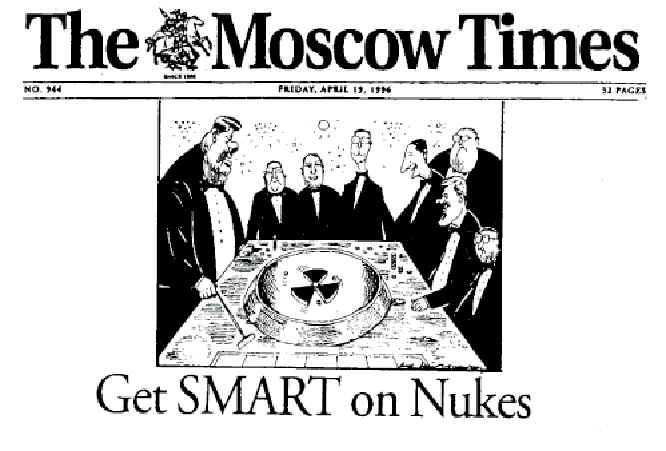

The first of two articles on nuclear security.Tomorrow’s
comment, by Graham Allison, deals with nuclear terrorism.
Previous summits between Presidents Bill
Clinton and Boris Yeltsin have produced a series of measures designed to
guard the "loose nukes" removed from retired nuclear weapons.At
this week's meeting, the two leaders should move beyond such safeguarding
strategies and agree to a timetable for destroying these materials which
are the heart of the two countries’ nuclear arsenals.
The second Strategic Arms Reduction Treaty -- START
II -- set a timetable to remove all but about 3,500 nuclear warheads per
side from their delivery systems by 2003.Both
sides are making progress towards this goal.But
there is still no requirement to dismantle the tens of thousands of removed
warheads (although both sides have begun to do so) or to eliminate their
fissile contents.
Without a doubt, the most urgent priority is to
ensure that these materials are extremely well protected so that terrorists
or rogue states cannot get hold of them.But
weapons materials are too dangerous to be simply stored indefinitely.Furthermore,
even the most leak-tight storage arrangements cannot prevent the United
States or Russia from using warheads again in a new arms race.Either
side could easily break out from commitments under START simply by putting
intact warheads back into operation or by assembling new warheads from
stored fissile components.
By the same token, either side could break the commitment
Clinton and Yeltsin reached at their last summit: ex-weapons materials
in excess of national security requirements will not be used to make new
weapons.
What if one or both sides change their mind about
how much is required for national security?Clinton
has taken a further step in pledging not to reuse excess materials in weapons
by unilaterally withdrawing roughly 20 percent of materials from the nuclear
stockpile and promising never to use them again to build weapons.Yeltsin
should match that gesture, but even such orders can be reversed, making
rearmament too easy in a period of conflict.
Weapons reductions under START are vital, and promises
not to reuse the released materials are helpful.But
we now need a joint commitment to eliminate irreversibly the core components
of the bomb.Clinton and Yeltsin
should sign a Strategic Materials Reduction Treaty -- SMART -- establishing
a framework and timetable for the disposition of weapons materials.Under
SMART, the United States and Russia should jointly declare that the majority
of our existing inventories of weapons-grade plutonium is no longer needed
for national security purposes, and should agree to reduce inventories
from the current level of about 100 tons apiece to 10 tons each by the
year 2025.
A similar goal should be set
for highly-enriched uranium.Each
side could comply with this ambitious deadline by any methods that ensured
irreversibility -- methods producing an end product so undesirable for
bomb use that it would be easier to just make bomb materials again from
scratch.
Whatever methods are selected to dispose of weapons
materials, it will take some time to achieve these large reductions.Therefore,
a relatively quick and inexpensive first step that SMART should include,
buying us increased security immediately, would be to deform the masses
of plutonium metal -- the "pits" -- such that they would have to be melted
down and re-fabricated in order to reuse them in a weapon.
But this step is still no substitute
for final disposition.Most of the
needed technology for disposition already exists, and the United States
and Russia should move faster to implement it.
The United States and Russia need to approach the
disposition of nuclear weapons materials as partners in peace. This will
require not only an agreed-upontimetable
for rapid, mutual reduction of weapons materials, but also a system for
verifying each other's compliance, as well as technical cooperation to
ensure safe processing and an irreversible outcome.
Cooperation with other nations will be needed as
well.The necessary funding must
be assured, and all G-7 nations should be willing contributors.Furthermore,
while most weapons materials should be disposed within the United States
and Russia, the use of facilities in other G-7 countries or elsewhere would
make more rapid reductions possible and should be considered, as long as
stringent safeguards and security can be guaranteed.
SMART would achieve disarmament consistent with
U.S. and Russian obligations under the Non-Proliferation Treaty, obligations
which we had better meet if we want to preach nuclear non-proliferation
to would-be weapons states.This
could add momentum toward the conclusion of two multilateral treaties that
the United States and Russia already support: a comprehensive ban on nuclear
testing and a ban on the production of fissile materials for nuclear weapons.Without
a formal pledge to eliminate weapons materials by the nations with the
largest arsenals, other countries will see us sitting on large inventories
indefinitely, with the option of future military use.Could
we then reasonably expect them to renounce any further development of their
own nuclear potential?
Even during the Cold War it was widely acknowledged
in both the United States and Russia that our nuclear arsenals grew far
larger than necessary.The difference
today is that the tide has turned, from an aggressive and dangerous arms
race to mutual recognition of the problem and cooperation in disarmament.We
should take advantage of these better circumstances and finally make the
commitment not only to remove bomb materials from delivery systems, but
also to eliminate the vast majority of them once and for all.
Neil Numark heads a Washington, D.C. consulting group specializing in nuclear safety and security and environmental protection issues.He contributed this comment to The Moscow Times.